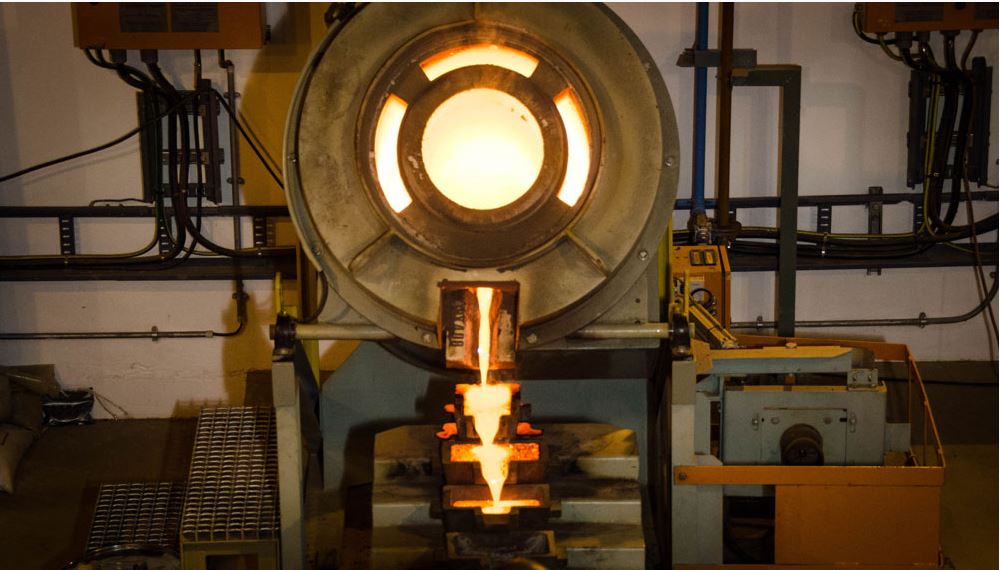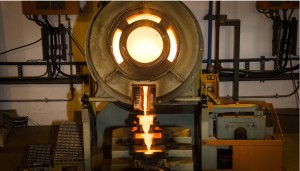Asanko Gold achieves commercial production in Ghana

A gold pour at the Asanko Gold Mine in Ghana, West Africa. Source: Asanko Gold Inc.

Asanko Gold Inc. [AKG-TSX, NYSE MKT] reported commercial production has been declared at Phase 1 of the Asanko Gold Mine, located in Ghana, West Africa, effective April 1, 2016, a quarter ahead of schedule. Gold production will continue to ramp-up during Q2 2016 as the mining operations access the main ore body in the Nkran pit. Steady-state operations are expected by the end of Q2 2016.
During March 2016, the processing facility processed 276,146 tonnes (8,908tpd (tonnes per day)) which is 111% of design capacity. The Phase 1 project construction is now essentially complete, ahead of schedule and within budget, with all ancillary infrastructure, such as workshops & warehouses installed and operational.
As at March 31, 2016, a total of 15,337 ounces of gold and 2,860 ounces of silver have been produced and shipped. 8,710 ounces have been sold at an average price of US $1,211 per ounce for sales of US $10.6 million. In addition to this, approximately 6,200 ounces of gold have been locked-up in the processing circuit.
Commenting on the performance to date, Peter Breese, President and CEO, said, “The ramp-up to steady-state production levels is progressing well and reaching commercial production a full quarter ahead of our original schedule is a fantastic achievement by our team. The milling circuit achieved design feed rates and target grind size within weeks of being commissioned. Since then, the milling rates have continued to improve as has gold recovery, both of which are exceeding design parameters by some margin.
The stripping of waste at the Nkran pit continues to advance as the pit is being opened up to expose the main zones of mineralization. 2016 will therefore be a year of two halves. The first half is focused on preparing the pit for continuous long life operations and steady-state production levels whilst the second half of 2016 will reflect the Definitive Project Plan (“DPP”) run rates and grade profile.”
Processing Update
The plant commissioning and ramp-up has been performing extremely well. The mills achieved designed grind and throughput within a few weeks of startup and are currently running at above designed levels, with the following results achieved:
- The mill processed 276,146 tonnes in March, which is 111% of design capacity;
- A best 7-day run to date of 70,710 tonnes – equivalent to 303,043tpm (tonnes per month) and two continuous days of milling in March which exceeded 11,000tpd;
- Notwithstanding higher throughputs, the mill grind of 85% passing 106 um is better than the plan of 80%;
- Power consumption in the SAG and Ball Mills are materially lower than planned which gives the plant the ability to run more material through the mills at a lower power cost per unit;
- Key reagent consumptions to date are at, or below, design parameters;
- Tailings residue grades are better than expected, with an average tails grade of 0.07g/t for March against a design of 0.15g/t, confirming the ore behaves well from a metallurgical standpoint;
- Current gold recoveries are exceeding expectations, achieving in excess of 94% over the last two weeks of March versus a design of 92.5%. Approximately 45% of gold is being recovered by gravity;
- Gold smelting and shipments are occurring on a weekly basis;
- As the mill continues to be optimized, the operations team are debottlenecking the flow sheet to stress test the mills up to 12,000 tpd.
Mining Update
The pushback of the Nkran pit continues to be a key area of focus and is advancing well, with a total of 28 million tonnes (Mt) mined since mining operations commenced early in 2015 against a plan of 26.2Mt. The pit has been placed under pressure to deliver ore tonnes to the milling facility which started operations six weeks ahead of schedule, ramped up to design throughput rates three months faster than expected, and is now consistently operating at more than 10% above design throughput rates.
As a result of this demand for feed, ore mining to-date has been predominantly bulk mining with a focus on mining higher rates from the pit in order to open up the main ore zones, as well as to give the pit more operational flexibility. The Company expects to continue to use a bulk mining approach during this stripping exercise in order to get to the main ore zones as quickly as possible. Consequently, lower head grades are being mined, with higher levels of dilution and gold losses than planned. This is expected to continue throughout Q2 until the main ore body is fully exposed.
The historical pit floor that hosts the main, continuous ore zones is on track to be exposed by the end of Q2 2016, when more selective mining will commence and the life of mine reserve grade is expected.
Bulk Mining Control Test
During the 3rd week of February, after the mills had achieved design capacity, a controlled, comprehensive test using a grade controlled, selectively mined ore block of ±54,000t was undertaken. This controlled bulk sample was an internal test to empirically evaluate the complete mining and gold recovery cycle, from grade control through mining, dilution, ore feed and metallurgical recoveries against the assumptions that were used in the feasibility study. A reconciliation of results of the test is shown in Table 1.
The grades and tonnes estimated from the resource model, through to the grade control model, through to plant feed were very closely correlated and well within the assumptions assumed in the feasibility study, which is very encouraging. In-situ density and long-term dilution parameters were also confirmed. Once the main ore zones have been accessed, work on formal grade control reconciliation will start.
Table 1: Bulk mining grade control test sample results
| Mineral Reserve Estimate |
Grade Control Model Estimate |
Actual Mined |
Actual Measured Plant Feed |
Variance Reserve to Plant Feed |
||
| Contained gold (g/t) | 1.63 | 1.77 | 1.76 | 1.70 | 4 | % |
Power Supply Update
In February 2016, Asanko signed a five-year Power Purchase Agreement (“PPA”) with the Volta River Authority, a parastatal power provider in Ghana. Power is being delivered via a 30km long, 161kV power line connecting the Mine site to the national power grid at the Asawinso substation. This is the main source of power being used for operations on the mine. The current tariff, which is subject to regular reviews based on the in-country energy mix and associated prices, is lower than the DPP estimate, published in November 2014.
In Q2 2016 the Company expects to produce 35,000 to 40,000 ounces. For H2 2016, the Company expects to produce 90,000 to 100,000 ounces, which is indicative of steady-state life of mine production rates.
As at March 31, 2016 the company had approximately US $72 million cash on hand
Asanko’s vision is to become a mid-tier gold mining company. The company’s flagship Asanko Gold Mine will be ramped-up to steady-state production levels of 190,000 ounces per annum is expected in Q2 2016.
